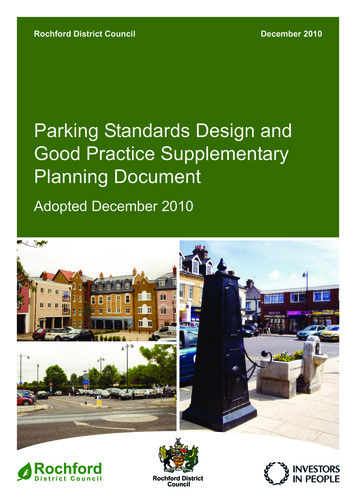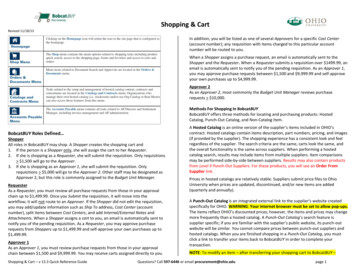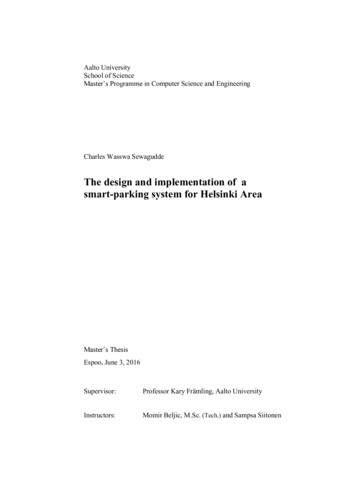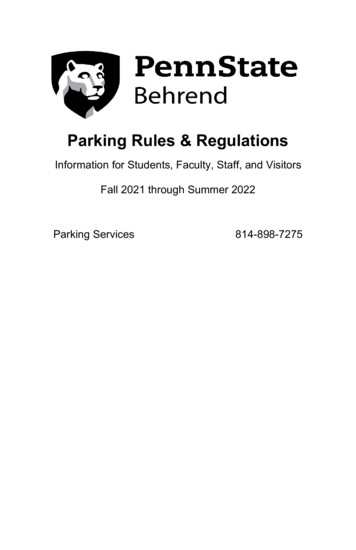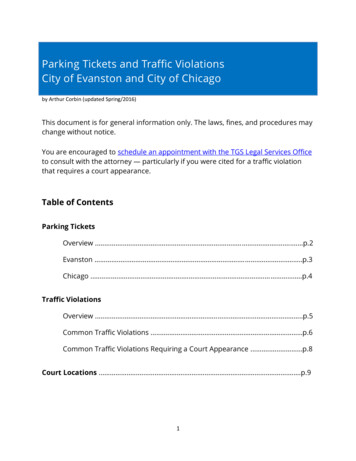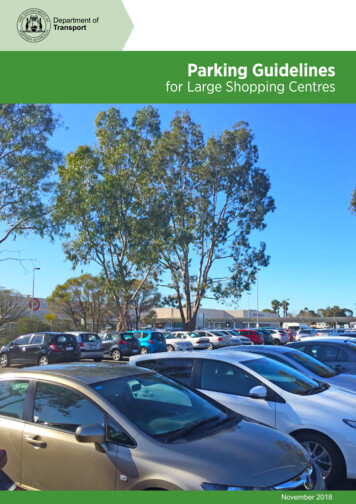
Transcription
Department ofTransportParking Guidelinesfor Large Shopping CentresNovember 2018
Contents1.Introduction2.What is the purpose of developing a Parking Supply and Management Plan (PSMP)?43.What typical objectives and strategies might be found in a PSMP?44.What are the advantages of developing a PSMP?65.What is the process for developing a PSMP?76.What should a PSMP contain?87.Further reading10This document has been published by the Department of Transportwith input from the Department of Planning, Lands and Heritage2Parking Guidelines for Large Shopping Centres
Parking Supply and Management PlanGuidelines for Large Shopping Centres01IntroductionLarge shopping centres are typically located within activity centres that have existing high quality services andinfrastructure in place to support access.Large shopping centres are generally described as a shopping centre with a total gross lettable retail floor areagreater than 10,000 square metres and typically incorporating at least one full-line department store and onemajor supermarket. Due to the variety of different land uses at large shopping centres, they are typically thebiggest generator of trips within their activity centre on weekdays and on weekends. They generate significantnumbers of access trips by staff, customers and delivery vehicles that impact the surrounding road network,public transport networks, and pedestrian and bicycle paths. As such, parking supply and management mustbe effectively managed at existing, redeveloped or new large shopping centres.In a Western Australian context, the majority of staff and customers access large shopping centres by privatecar. This is largely due to the location of large shopping centres and the supply and availability of car parkingthat is generally free. The Western Australian Planning Commission (WAPC), with advice and support fromthe Department of Planning, Lands and Heritage (DPLH), Department of Transport (DoT), Public TransportAuthority (PTA), Main Roads WA (MRWA), and the relevant local government agency (LGA), typically place capson centre parking provision to help reduce on-road congestion and encourage greater use of public transport,walking and cycling.However, as car trips will remain one of the most important forms of access to existing and new large shoppingcentres, it is important that the parking provided is well-managed and that priority is given to people who needparking the most , such as the elderly. A distinction should be made between customers and staff and theirrelationship to the centre, noting that the government does not support paid parking for staff. As such, largeshopping centres should prepare a Parking Supply and Management Plan (PSMP) in order to manage supply ofparking and the associated policy and management strategies to mitigate impacts of parking on their centre’sinternal and external road networks.These Guidelines should be read in conjunction with the following documents, including: Parking Guidelines for Activity Centres (DoT 2016); and Travel Plan Guidelines for Large Shopping Centres (DoT 2018)Parking Guidelines for Large Shopping Centres3
02What is the purpose of developing a PSMP?A PSMP is intended to link parking supply with anappropriate management strategy. The preparationof a PSMP provides an opportunity for shoppingcentres to review current parking supply andutilisation, estimate future parking supply and amendthe existing parking management strategy.The Development Application (DA) or planningapproval process will have normally set the overallmaximum (and minimum) number of car parkingspaces to be provided. A PSMP will often beproduced first as a condition of developmentapproval and will often be written in conjunctionwith a travel plan. A travel plan is also a condition ofdevelopment and is intended to outline measures toreduce centre-generated car trips and encourage theuse of other transport modes. Refer to Travel PlanGuidelines for Large Shopping Centres (DoT 2018)for further guidance to support access for activetransport options to large shopping centres.The WAPC, DPLH, and DoT request that a PSMP(and a related travel plan) is produced by a shoppingcentre owner (or by an operator on the owner’sbehalf) to govern the supply and management ofa centre’s car parking bays and bicycle parking.The PSMP also demonstrates that the shoppingcentre has considered the impacts of parking to the03wider road, public transport, pedestrian and cyclingnetworks during weekdays and weekends.Briefly, a PSMP will typically outline a centre’s policiesand commitments regarding: the allocation of approved car parking bays todifferent purposes; parking controls such as time limits andthe way that they will be enforced; the configuration and management of bicycleparking and related facilities; the use of way finding systems; and monitoring and reporting of parking outcomeswithin and around the centre.DoT encourages the preparation of a PSMP wherethe introduction of paid parking at shoppingcenters is being investigated to ensure a range ofmanagement strategies are considered.A shopping centre’s PSMP should continue to beupdated over the life of the centre, with governmentapproval sought for all but the most minor changes.If a shopping centre is sold, the responsibility forfulfilling the commitments in a PSMP will transfer to anew owner.What typical objectives and strategies might be found in a PSMP?Clear and practical objectives should be identified in a PSMP to guide the proposed management and supplyof parking spaces. Many of the PSMP objectives might be taken from the shopping centre’s travel plan whichshould be developed in parallel with the PSMP. The objectives will generally address the following issues relatedto sustainable travel alternatives and parking management, including: making efficient use of bays to meet customer and staff needs while discouraging commuters; increasing the proportion of people accessing the centre by more sustainable transport modes (alternativesto the private car); minimising traffic congestion around the centre, especially at peak traffic times; minimising overflow parking problems around the centre; giving special needs groups priority access to parking bays; and providing convenient access to safe and well maintained bicycle end-of-trip facilities.These objectives will also be accompanied by strategies to achieve them. It will often make sense to differentiatestrategies by the broad user groups , such as “customers” or “staff”, who use parking differently and with whomthe centre has a different relationship. The government does not support paid staff parking strategies as partof the PSMP, however any pricing of parking supply proposed by centre owners must be outlined. Some of thepossible strategies are listed in Table 1 on page 5.4Parking Guidelines for Large Shopping Centres
Table 1 – Possible strategies supporting a PSMPPossible strategies supporting a PSMPMaximise flexibilityDiscourage commuter use Avoid designating tenant bays Restrict morning peak access Retain centre ownership Accommodate for shift workers Allow public use out of businesshours Monitor commuter usePrioritise customersStaff mode shift Allocate convenient bays Provide end of trip cycle facilities Restrict staff allocations Provide benefits for non-carcommuters Actively manage staff parking Allocate bays according to needCustomer mode shiftManage overspill Advertise alternative transportoptions Monitor overspill Develop peak demand strategy Accommodate car sharing Overspill carpark and shuttles Accommodate cycle trips Fund local governmentenforcementSearching for parkingSpecial needs Wayfinding systems Parking availability informationParking Guidelines for Large Shopping CentresAccommodate for disabled,elderly and parents5
04What are the advantages of developing a PSMP?The primary reason that a PSMP for a large shopping centre is prepared is to guide parking supply andmanagement as a condition of a DA for the centre’s development of redevelopment. However, a PSMP can alsoprovide a number of benefits for key stakeholders such as centre managers, customers, tenants, staff and thewider community. The table below outlines some of these key benefits.Table 2 – key stakeholder benefitsStakeholder Lower parking provision costs (land and construction) through more efficient use ofparking bays;Centre gains reputation for greater accessibility and lower congestion; andBetter relationship with surrounding residents and businesses.Customers Greater availability of parking when needed through better management of spaces.Tenants andstaff Ability to find available bays more quickly through better way finding information;More convenient cycling to centres through well-managed bicycle parking; andBetter public transport services resulting from increased patronage. Less traffic congestion, noise and pollution around centres, especially in peaks;A greater proportion of trips made by non-car modes, with car parking stillaccessible when needed; andBetter public transport services resulting from increased patronage and reducedon-road congestion.Centre owner /managerWidercommunity6Potential benefits Parking Guidelines for Large Shopping Centres
05What is the process for developing a PSMP?There are a number of key stakeholders groups that are impacted by the preparation of the PSMP. Stakeholderengagement should be a collaborate process and should occur early and regularly. Early engagement withDoT and the relevant LGA is also recommended to support a unified and consistent approach to the parkingmanagement strategy at the centre. However, stakeholder input should ensure that the preliminary principlesunderpinning development of a PSMP relating to good business management, social responsibility andenvironmental stewardship are still maintained. There are five basic steps in developing a PSMP. These stepsinclude:1) Identify the context and objectives for the PSMPa. Check development approval documents for any parking requirements;b. Outline traffic conditions and parking controls in surrounding streets (which can often be sourced fromthe development’s Transport Assessment); andc. Develop a set of clear objectives (also referring to the shopping centre’s travel plan to consider includingany of its objectives relevant to parking management).2) List possible strategies for achieving the PSMP’s objectivesa. Consider suggestions in this document and other examples of ‘good practice’ for adaptation to thecentre in question;b. Consult with centre users (identified or potential tenants) on the practicalities of implementation; andc. Consult with the DoT, MRWA and the relevant LGA.3) Choose strategies to be adopted and record any other decisions made, ensuring that they canbe assessed against measurable outcomesa. Explain why particular parking management strategies were chosen;b. Produce plans showing parking bay allocation for different users, wayfinding systems, and bicycleparking, lockers and showers;c. Provide details of proposed parking time limits, parking enforcement policies and practices, andaccess arrangements for cycling facilities; andd. Outline proposed promotion and communication to tenants, staff and customers.4) Commit to monitoring, review, and rectification proceduresa. Provide details of monitoring regimes for car parking spaces and bicycle facilities;b. Give schedules for (e.g. annual) reports and lodgement with government;c. Identify contact person/position with ongoing responsibility for the PSMP and outline procedures formanaging dissatisfaction, regular reviews and amendments (including seeking government approval); andd. Give voluntary undertakings on operation of facilities and propose consequences for the centre where itdoes not meet PSMP commitments, e.g. nominating a ‘fine’ to be paid towards transport improvementsin the local area for every week the annual report is late.5) Seek approvala. The PSMP should be endorsed and approved from the DoT, MRWA, and the relevant LGA; andb. Lodge a copy of the final report with the above organisations.Parking Guidelines for Large Shopping Centres7
06What should a PSMP contain?When identifying what is required within the PSMP, early consultation with government agencies, such asDoT, DPLH and the relevant LGA is strongly recommended because they can provide guidance on the levelof detail required for a PSMP and can provide the ultimate approval or endorsement of the PSMP. Guidanceprovided could be particularly helpful for challenging management issues such as staging of parking supply orapplication of interim parking management measures. However, responsibility for developing specific contentrests with each shopping centre. It is recommended that a PSMP should address all relevant matters within thefollowing table:8Parking Guidelines for Large Shopping Centres
Table 3 – Content of the PSMPRecommended PSMP contentContext Location Map Summary of development Development Approvalrequirements Parking controls on publicparking within 400m of centresboundaries Details of the landlord/owner andoperatorObjectives and possiblestrategies Outline of policy objectives Identification of travel planobjectives Possible strategies for achievingthe objectives Consideration of ‘good practice’examples A record of consultationDecisions madeMonitoring, review and approvals Explanation of chosen strategies Parking usage monitoring regimes Bay allocation plan Maintenance and upkeep details Wayfinding plan Reporting schedule End-of-trip facility plan Accountabilities Parking time limits Complaints policy and reporting Enforcement plan List of measurable outcomesPSMP review and amendmentcommitments Communications strategy Evaluation, effectiveness reviewand actions Copies of relevant approvalsParking Guidelines for Large Shopping Centres9
07Further reading1) On parking management in general:- Litman, T., Parking Management: Strategies, Evaluation and Planning. Victoria Transport Policy Institute, 5November 2013.2) ‘Good practice’ case studies:- Bluewater Travel Demand Management Case Study (UK): http://usf-cutr.custhelp.com/app/answers/detail/a id/2887/ case-study%3A-bluewater-(uk)10Parking Guidelines for Large Shopping Centres
Parking Guidelines for Large Shopping Centres11
CONTACTDepartment of Transport140 William StreetPerth WA 6000Telephone: (08) 6551 6000Email: ITPstatutoryreferrals@transport.wa.gov.auWebsite: www.transport.wa.gov.auThe information contained in this publication is provided in good faith and believed to be accurate at time of publication.The State shall in no way be liable for any loss sustained or incurred by anyone relying on the information. 02082018DoT 14980521
Parking uidelines for arge Shopping entres. 3. Large shopping centres are typically located within activity centres that have existing high quality services and infrastructure in place to support access. Large shopping centres are generally described as a shopping centre with a total gross lettable retail floor area
